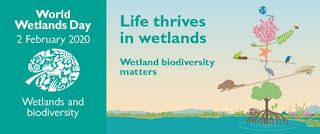Plastic Pollution, Wetlands & Migratory Species: Girls and Women in Science with RePlastic Solutions
In February we observe two important days:
- Feb 2: World Wetlands Day – Wetlands and Biodiversity
- Feb 11: International Day of Women and Girls in Science

And this February, India plays host to the Thirteenth Conference of the Parties to the Convention on Migratory Species (#CMSCOP13) in Gandhinagar, Gujarat, from February 15-22, 2020. The mascot for this conference is the Great Indian Bustard.

Now, what's the connections to these three things and this blog on all things Re.Plastic - REplacing, REducing, REcycling & REusing Plastic, you ask and the answer is the problem of plastic and girls and women scientists championing alternatives to plastics and finding ecologically friendly RePlastic solutions. In addition to having popular ambassadors for the Bonn Convention on Migratory Species investing in women and girls in science finding solutions to the plastic crises that threatens the health of migratory species and their habitat will make a huge difference.
News from #CMSCOP13: @BonnConvention announces #HumanSwan #freediver #explorer #environmentalist @sachadench as #Ambassador for #Avian species; #conservationist #IanRedmond OBE as for #Terrestrial species #SDG15, & #Bollywood actor @RandeepHooda for #Aquatic species #SDG14- Kudos pic.twitter.com/is0RWiFfZm— Raakhee Suryaprakash (@10sunshinegal) February 18, 2020
Now in 2020 the theme for World Wetlands Day is "Wetlands and Biodiversity" while for the Day of Women and Girls in Science it is "'Investment in Women and Girls in Science for Inclusive Green Growth." World Wetland Day is observed on February 2nd as it was the day the Convention on Wetlands was adopted in the Iranian city of Ramsar in 1971, hence the alternative name the Ramsar Convention.
At the CMSCOP13 we celebrate a "Super Year for Nature," as well as receiving Ramsar Site statuses for 10 more Indian wetland and marsh ecosystems. And one way in which we can do this is tackle the plastic waste problem by empowering and funding scientists and innovative young people, especially women and girls working to find RePlastic solutions. The Re.Plastic Changemakers as it were.
A major threat to wetlands and the Great Indian Bustard as well as many avian and aquatic migratory species is plastic waste. In urban centers its the wetlands that are used as landfills and garbage dumps and then even co-opted and drained to make way for prime real estate development. The health of migratory species as well as thriving biodiversity depends on healthy wetlands. And by Saving Wetlands we can save ourselves from climate disasters as they are one of the best natural carbon traps available to us.
By tacking the problem of plastic pollution, developing and marketing RePlastic solutions could be a win-win for wetlands, migratory species and women and girls in science.
Take, for example, Shelby O'Neal our first ever featured RePlastic Changemaker, this Girl Scout from California's interest in science was fostered by the Monterey Bay Aquarium's “Young Women in Science” program which in turn saw her tackle plastic pollution by starting Junior Ocean Guardians and the #NoStrawNovember movement.
Then there is another RePlastic Changemaker and Woman in Science, Dr Sharon Barak of Solutum who invented a water soluble 100% biodegradable plastic alternative showcased by the popular Nas Daily videos:
There is Australian teen Angelina Arora who has developed a bioplastic from prawn shells a perfect example of what investment and encouragement of girls in science can do to tackle existential crises.
x
What about the plastic waste that's already there, again these young women in science have a solution:
G. Divyapriya and Ramya Selvaraj are the wonder women of IIT-Madras who have developed a multi-award winning solar-powered mobile system that converts non-recyclable plastic into fuel. This solar-powered mobile Waste to Energy (WtE) unit yields approximately 0.7 liters of fuel oil per kilogram of plastic through pyrolysis.
 |
| G. Divyapriya of IIT-Madras |
 |
| Ramya Selvaraj of IIT-Madras |
Through the work of girls and women in science and many like them working to develop alternatives to plastics or eco-friendly methods of dealing with existing plastic waste we can ensure that we can save our wetlands, migratory birds, sea-turtles, whales and other migratory species from plastic pollution. This hat-trick exemplifies the sustainable development goals right from SDG5 - Gender Equality to SDG12 - Responsible Consumption and Production to SDG13 - Climate Action, and SDG14 & SDG15 Life Below water and Life on Land as well as epitomizing Industry, innovation and infrastructure.



Comments
Post a Comment